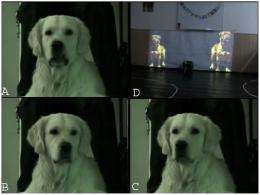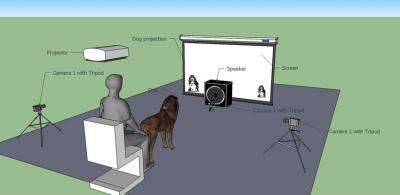December 17, 2010 report
Dogs can tell canine size through growls

(PhysOrg.com) -- New research has demonstrated that dogs can tell the size of another dog by listening to its growls. They are able to do this so accurately they can match the growl to a photograph of a dog of the same size.
Lead researcher Péter Pongrácz of the Eötvös Loránd University in Budapest, Hungary had previously demonstrated that dogs have different growls for different purposes, and have a specific "this is my bone" growl. The new study tried to determine if dogs could identify the size of another dog from its growl.

The researchers recruited 96 dogs of various breeds and ages from the database of the Clever Dog Lab in Vienna. They presented a test group of 24 of the dogs with two projected images of a large (over 60 cm) or small (under 52 cm) dog: one life-sized and one of the same dog scaled up or down by 30 percent. They then played a recording of a food-guarding growl from either a small or large dog, with the sound coming from midway between the two images. They filmed the behavior of the dogs to determine which of the images they looked at first and for longest.
The control dogs were shown either images of the silhouettes of large and small cats or large and small images of shapes such as triangles while listening to the recorded growls. All 24 dogs in the cat group were familiar with cats and either lived with a cat or had done so in the past. A final control group of 24 was shown large and small dog images while listening to Brownian noise.
All the dogs were well-socialized animals and were tested while their owner was present to encourage them to be comfortable in the laboratory environment. To ensure owners did not unconsciously affect their dog’s behavior they were listening to music via headphones throughout the experiment and were unable to hear the growls.
The results, published online in the journal PLoS ONE, were that 20 of the 24 test dogs looked at the image of the appropriate-sized dog first and looked at it longest. The controls presented with images of triangles showed little interest in the images, while those shown images of cats spent more time looking at them.
The control dogs looking at pictures of cats often looked first at the image on the left, a finding that supports earlier studies that have found dogs tend to look to the left when presented with something unexpected. No such bias was found in the other groups.
Pongrácz said the dogs’ ability to match the growl to the photograph of a dog of the same size is a "complex cognitive talent previously seen only in primates." The research also shows that dogs do not lie about their size, and this is the first time research has shown animals can determine another’s size by the sound it makes.
More information: Faragó T, Pongrácz P, Miklósi Á, Huber L, Virányi Z, et al. (2010) Dogs' Expectation about Signalers' Body Size by Virtue of Their Growls. PLoS ONE 5(12): e15175. doi:10.1371/journal.pone.0015175
© 2010 PhysOrg.com













